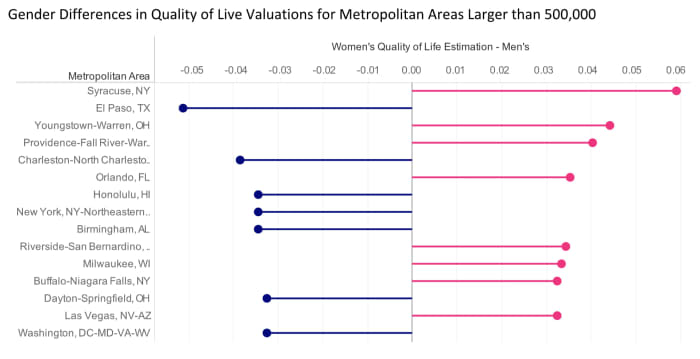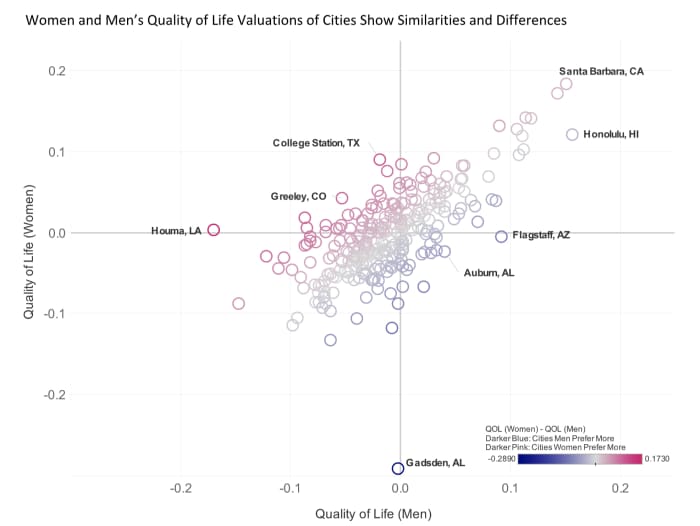This post was originally published on this site
Location, location, location. Every real-estate agent knows location influences the price of a home, even the wages paid for similar jobs. But while men and women can agree on preferring certain amenities, like beaches, mountains and moderate weather, they often disagree on what’s the better city.
For example, between two towns both with mountain views, single women prefer Greeley, Colo. and single men prefer Flagstaff, Ariz., according to our research of their preferences using 283 largest metropolitan statistical areas with at least 100,000 people. Flagstaff is the 10th highest-rated city for men, but is not even in the top 100 for women (at 135). Greeley ranks among the top 50 cities for women (42nd), but ranks near the bottom for men (at 234th).
College towns typically offer their residents a high quality of life. But single men and women disagree over which are better. Men would prefer Auburn, Ala., home to Auburn University, while women would prefer College Station, Texas, where Texas A&M is located. Auburn ranks 30th for men and 179th for women. College Station ranks 150th for men and 13th for women.
But where single men and women disagree most is over Gadsden, Ala. Women say the quality of life there is by far the worst of the 283 metropolitan areas we studied. Men say it’s average.
Gadsden has a relatively hot climate, relatively few restaurants, relatively few public parks and relatively less progressive gender role attitudes. It is a blue-collar town that is home to a large Goodyear plant. But not just any Goodyear plant. This is the plant that because of its egregious gender pay discrimination against one of its managers, Lilly Ledbetter, led to new federal legislation toward gender equity in the workplace, the Lilly Ledbetter Fair Pay Act (the first piece of legislation signed into law by then-President Barack Obama).

Amanda Weinstein, Lockwood Reynolds
For a full list of all 283 metro areas, click here.
To be sure, men and women are in broad agreement on the overall quality of life in the top-ranked cities, many of them situated along the West Coast, places like Santa Barbara and San Jose, Calif. – both of which rank in the top 10 for men and women along with Honolulu, Hawaii. On the East Coast, among the top-ranked cities for men and women are Boston, Mass.; Portland, Maine; and Panama City, Fla. (all rank in the top 25 cities for men and women).

Amanda Weinstein, Lockwood Reynolds
Click here for an interactive version of that chart.
When we look for reasons behind the differences in the evaluations of quality of life by men and women, we find they tend to like the same things, but to very different degrees. For example, quality of life in a city increases for men and women when violent crime rates are lower – but more so for women (as women experience a higher level of fear of crime). Similarly, better air quality increases quality of life for men and women – but more so for women (as women are more concerned about environmental quality than men).
Greeley offers lower violent crime rates and better air quality than Flagstaff. College Station also has lower violent crime rates and better air quality than Auburn.
No one likes a long commute – but women especially work to avoid it. Though women and men seem to prefer cities with better access to public transportation, men exhibit stronger preferences for public transportation. Thus, some of the nation’s largest and most congested cities — New York, Washington, D.C., and Los Angeles — are less preferred by women (Figure 2).
Large cities do offer an amenity single women find appealing – single men. A better “marriage market” appears to boost the quality of life valuations for women but not for men.
Between the college town and the mountain views, women would choose the college town with a higher percentage of well-educated single men (College Station over Greeley) while men would choose the mountain views (Flagstaff over Auburn).
Although the marriage market seems more important to women than men, women are likely looking to find a mate who will be their equal (women and men are increasingly marrying partners with similar education levels and interests). Cities in states with less traditional and more egalitarian attitudes toward gender roles have higher quality-of-life estimations for women. Single men also show preferences for places with less-traditional gender attitudes, but their preference is, again, much smaller than for women.
Slightly more progressive gender role attitudes in Texas compared to Alabama helps push College Station above Auburn for women. Auburn offers comparatively more places to drink while College Station offers more restaurants (women prefer to allocate a larger share of household expenditures on restaurants).
What does this mean for local officials looking to boost the appeal of their city? They can’t create mountains or moderate weather (perhaps they can create a beach, if Paris is a guide), but they can shift their focus away from attracting businesses toward attracting people and figure the businesses will follow.
If they do adopt this strategy, they may want to invest in the amenities that women prefer, since frequently they are also valued (though to a lesser extent) by men. In fact, we find that cities more preferred by women (cities with higher quality of life valuations than men) have experienced higher growth.
Women’s underrepresentation in state and local government (only about a quarter of mayors and state legislators are women) may mean that the amenities that women prefer receive less investment.
I saw this with my conversation with Heather McGhee (former president of Demos and author of “The Sum of Us”). She discussed the underinvestment and even disinvestment in public amenities such as parks – an amenity for which women show stronger preferences — and how this underinvestment and disinvestment in these types of public amenities leaves our communities and its residents (and the economy) worse off.
Amanda Weinstein is an associate professor of economics at the University of Akron in Ohio and a co-host of The Suburban Women Problem Podcast. Follow her on Twitter @ProfWeinstein. Lockwood Reynolds is an associate professor of economics at Kent State University, also in Ohio.


